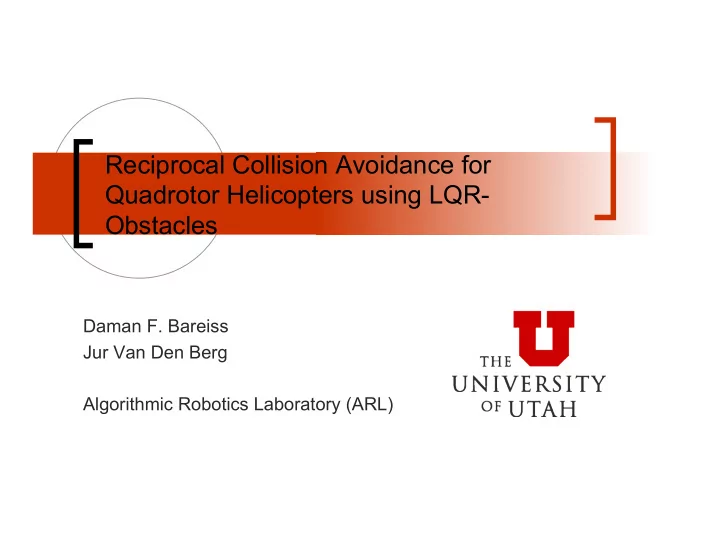

Reciprocal Collision Avoidance for Quadrotor Helicopters using LQR- Obstacles Daman F. Bareiss Jur Van Den Berg Algorithmic Robotics Laboratory (ARL)
Problem Statement n Multiple robots with linear dynamics in a common workspace n Decentralized collision avoidance without communication between the robots n Similar to humans walking, on a campus for example n How can it be done? The University of Utah
Velocity Obstacles n All velocities resulting in a collision between agent A and agent B [Fiorini, Shiller, ‘98] n Used for reactive collision avoidance among agents The University of Utah
Control Obstacle n Need obstacle for robots with dynamics ¡ VO’s do not consider robots with dynamics n Prefer higher-level control obstacle ¡ Low-level control obstacle is difficult n For quadrotors, selecting a position or velocity is much simpler than individual motor thrusts The University of Utah
LQR Feedback Control n Optimally control robot towards a goal without applying extreme control inputs n Dynamics: n Cost: n Control Input Minimizing Cost: n Higher-Level Control Input: The University of Utah
LQR Feedback Control n Closed-Loop Dynamics: n Relative Formulation: n Know how to control, but when do the robots collide? The University of Utah
Collision n Definition: The University of Utah
Relative LQR-Obstacles n Given relative state: The University of Utah
Avoiding Collisions n The LQR-Obstacle defines a set of relative target velocities that would result in collision n To avoid collision target velocity must not be within that space: n Equivalent of VO for robots with dynamics [van den Berg, 2012] The University of Utah
RCA – Pair of Robots n Only accounts for passive robots, must expand for active robots n Must consider action of other robot or oscillations in motion can occur n Designed for each robot to take 50% of the responsibility The University of Utah
RCA – Pair of Robots n Relative target velocity must be chosen: n Must define set of potential target velocities, or RCA set The University of Utah
RCA – Pair of Robots The University of Utah
RCA – Multiple Robots n Each robot creates an RCA with respect to every other robot n The combination of these creates a target set avoiding collisions with every robot The University of Utah
Determining Preferred Velocity n Given a goal position, what velocity is required? n Knowing that preferred velocity, find the closest such velocity that avoids collision n Use of a second layer of LQR control: ¡ Cost: ¡ Substitute initial control policy: ¡ New control policy: The University of Utah
Implementation Details n C++ Simulator n Qhull Library for convex hull of ellipsoids n GJK-Algorithm to find escape velocity n RVO2 Library for linear programming n Simulation Computer Specifications: ¡ Windows 7 Professional 64-bit ¡ Intel i7-2600 CPU, 8GB RAM The University of Utah
Results – 2 Quadrotors n Videos can be found at: ¡ http://arl.cs.utah.edu/research/rca/ The University of Utah
Results – 24 Quadrotors n Videos can be found at: ¡ http://arl.cs.utah.edu/research/rca/ The University of Utah
Results – 100 Quadrotors n Videos can be found at: ¡ http://arl.cs.utah.edu/research/rca/ The University of Utah
Results The University of Utah
Conclusions n Simulation results displayed validity of our approach. n Robots with linear dynamics were able to independently navigate to a goal position with no communication between the robots in real time The University of Utah
Conclusions n Limitations ¡ Requires position and velocity to be contained in the state of the robot ¡ Geometry of robot translates but does not rotate ¡ Robots of same dynamics ¡ Requires full state observation The University of Utah
Future Work n Expanding algorithm for robots with different dynamics n Incorporating a state estimator with possible uncertainties n Implement algorithm on real quadrotors to obtain physical data The University of Utah
Questions The University of Utah
Recommend
More recommend